Affiliate disclosure: This post may contain affiliate links. Please see our Privacy Policy.
Those cute little canned mandarin oranges were a staple in my grandmother’s holiday cooking. She’d use them pretty up a fruit salad or decorate the edge of a platter.
I’d spend my time trying to sneak in under her and steal a tiny slice for myself. Now that I have my own little orange thieves underfoot, I’m canning oranges of my own.
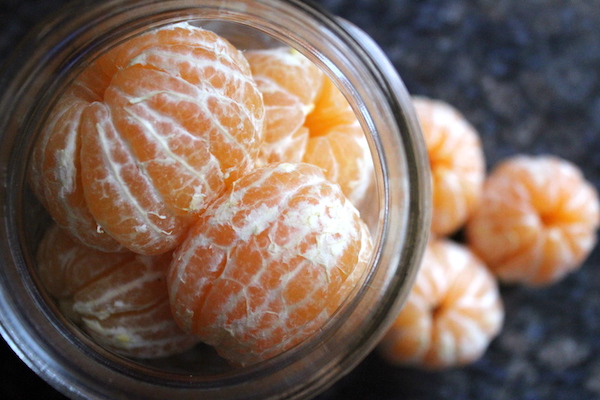
Oranges are a high acid food, and they’re perfectly safe for water bath canning. This applies to all types of oranges including navel oranges, mandarins, clementines, and tangerines. The California oranges of my childhood are slightly more acidic than Florida varieties, but they’re all well below a safe canning pH of 4.6.
Preparing Oranges for Canning
Oranges can be canned whole or in segments. Segments tend to work better for larger navel oranges, but smaller clementines are perfect for canning whole. Regardless of whether you can oranges whole or in segments, they obviously need to be peeled.
Remove as much of the white pith as possible, while avoiding puncturing the segment membranes. If you cut into the segments the juice will run into the canning syrup, and they’ll lose flavor that way.
For canning whole oranges, it helps to remove the pith from the center of the orange as well as the big hunk of pith that tends to sit at the flower or navel end of oranges. It can be tricky to remove it without breaking the orange into segments, but if you take a finger and gently slide it through the center of the orange the navel end pith and the stringy interior pith will all come out together.
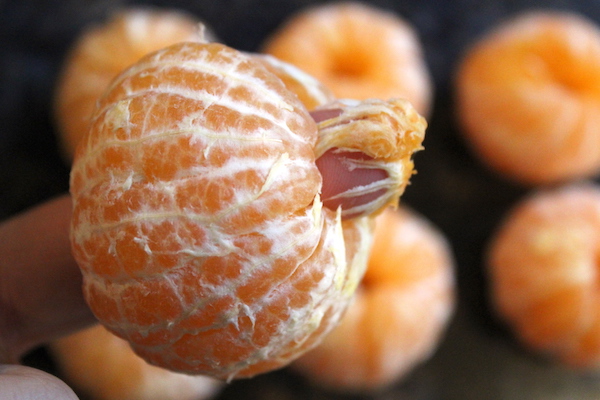
Creating space in the center of the orange is also helpful to allow the syrup to penetrate into the center of the fruit. For orange segments, simply remove as much pith as possible and break the fruits into individual pieces.
How to Can Oranges
Oranges are usually canned “raw pack” which means that the fruit is packed into the jar without any pre-cooking. A boiling hot syrup is poured over the top before the jars are sealed and processed in a water bath canner.
When canning oranges, choosing the liquid is completely up to you. Straight water is fine from a safety perspective, but it’ll wash out the oranges and leave them flavorless.
It’s generally recommended that you can oranges in a very light, light or medium sugar syrup. Sugar and water measurements for different canning syrups can be found here.
An extra light syrup approximates the amount of natural sugar in the fruit and will help them keep their flavor and sweetness without adding extra. Dissolve sugar in water and bring it to a rolling boil before pouring it over oranges packed in canning jars.
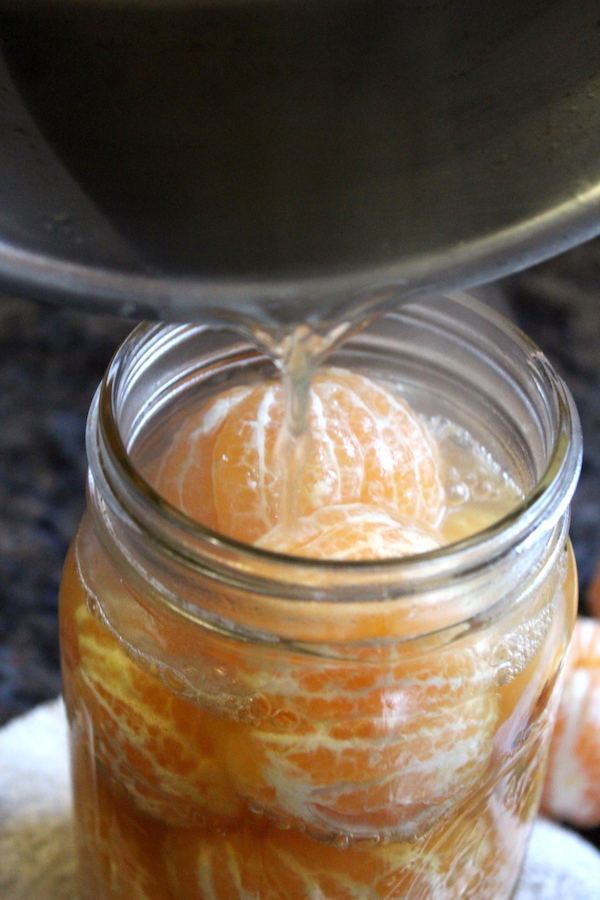
It takes about 2 pounds of orange slices to fill a quart canning jar, and roughly 3/4 of a pound fits in a pint canning jar. For whole oranges, I can fit about 10 clementines in a quart canning jar. That works out to roughly 1 1/2 pounds of whole oranges per quart.
Pack the oranges tightly, as they’ll shrink a bit during canning.
Oranges require 1/2 inch headspace. Both pints and quarts are canned for 10 minutes below 1000 feet in elevation, or 15 minutes up to 6000 feet in elevation.
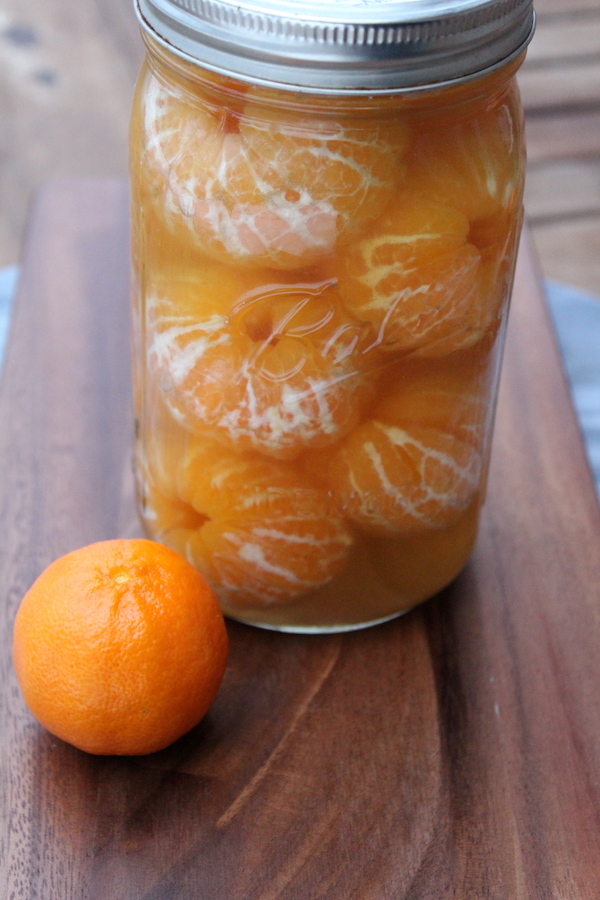
Canning Oranges ~ Variations
I tend to can oranges in a simple light sugar syrup, which leaves them flexible for future uses. Honey syrup is also a spectacular idea, and you can add spices if you choose.
- The Ball Complete Book of Home Canning suggests canning oranges in a spiced honey syrup, made by dissolving honey in water and simmering it with whole spices such as cinnamon.
- Preserve It! has a tasty recipe for canning oranges in a caramel syrup. The sugar is first cooked into a light caramel syrup before more water is added to make the canning syrup.
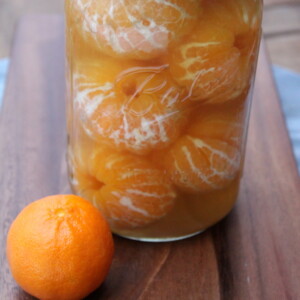
Canning Oranges
Ingredients
- 15 lbs oranges, peeled and membranes removed
- 1 1/4 cups sugar
- 10 1/2 cups water
Instructions
- Peel the oranges and remove as much white membrane as possible. Divide oranges into sections, or leave very small clementines and tangerines whole if desired.
- Pack oranges tightly into canning jars, leaving at least 1/2 inch headspace.
- Bring water and sugar to a boil in a saucepan and stir to dissolve sugar.
- Pour boiling sugar syrup over oranges, leaving 1/2 inch headspace. Seal with 2 part canning lids.
- Process in a water bath canner for 10 minutes below 1000 feet (both pints and quarts). Increase time to 15 minutes for 1000 to 6000 feet in elevation.
Notes
Nutrition
Nutrition information is automatically calculated, so should only be used as an approximation.
More Ways to Preserve Citrus
Looking for more ways to preserve citrus this season? Here are some of my favorite canning recipes:
- Orange Jam
- Salt Preserved Lemons
- Canning Lemons (3 Ways)
- Canning Lemon Curd
- Citrus Seed Pectin for Canning
- Kumquat Jam
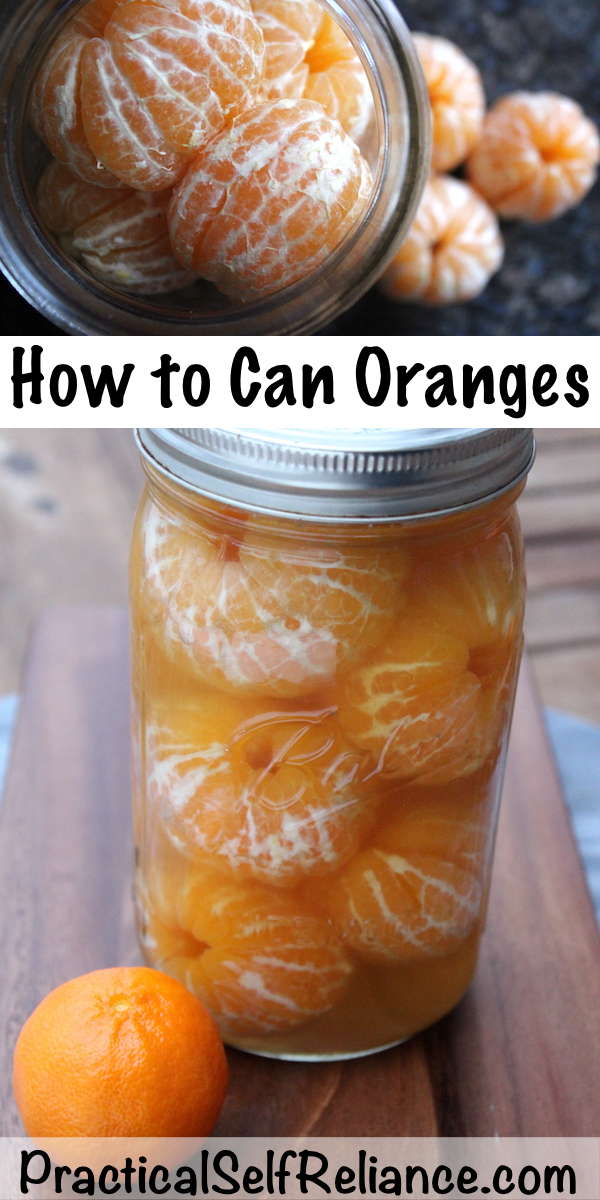
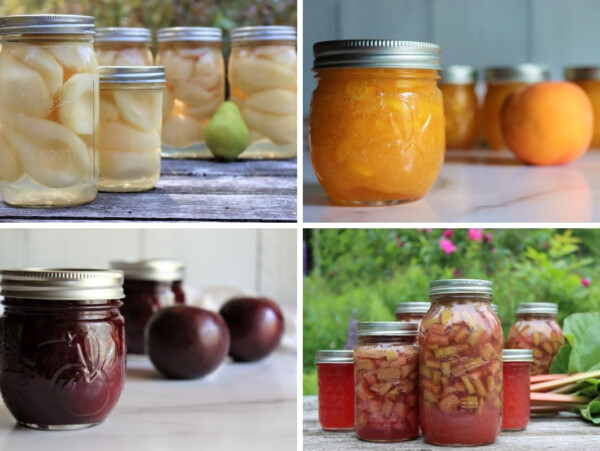

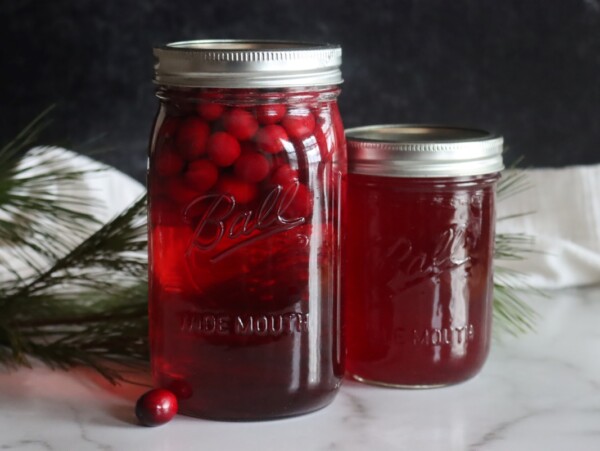

I can pints of clementines yesterday in your suggested light syrup. Peeled as much white pith off as possible. One jar did not seal. Takes the oranges from the unsealed jar. Great texture, but so bitter we couldn’t eat them. Disappointing.
Oh no. I’m so sorry that happened.
I just watched a video wherein a woman placed tangerines in a jar, poured boiled water over, capped the jar and left it to sit for 15 minutes. She then drained the water and poured in boiled simple syrup to the top and tightened on the lid with a special tool that seemed to seal it. Nothing more. No canning. Is this safe?
No, this is not a safe canning procedure. The lids will seal themselves on a hot jar with no special tool needed. A sealed lid does not necessarily equal safely canned food. Food must be processed for the proper amount of time under the proper conditions in order to be safe. This process varies depending on the food that is being canned.
Thanks. That unfortunately confirms what I thought. I definitely appreciate your knowledge.
You’re very welcome.
can i use grated orange peel to up the orange taste if it is organic or does the oil affect the process?
That should be fine. What I’d suggest though, is making an “orange sugar” with the zest and then turning that into your canning syrup, then straining the peel out. You’ll have really orang-y syrup that way, but no zest chunks (and zest can get bitter in jars over time). I describe that process in my article on canning lemonade concentrate (which would be the same, but just with orange zest instead, and no juice…) Info here: https://creativecanning.com/canning-lemonade/
I have a steamer for canning. How long should I steam the canned mandarin orange
You can safely adjust water bath canning recipes for the steam canner. Here is an article that explains the adjustments that you will want to make. https://fyi.extension.wisc.edu/safefood/2020/08/18/an-update-on-safe-use-of-steam-canners/
I found your site recently and found some things to try. I just processed 8 pints of clementines for the first time. I am excited. Your site is organized and pictures speak volumes. Thanks!
NC
You’re very welcome. So glad you enjoyed the post.
My husband will eat mandarins by the can as many times as he can until my supply runs out (speaking about commercially canned) he likes segments what is the down side of canning segments, I plan to can in 1/2 pts. in a very light syrup, using store bought mandarins. thank you L
There really isn’t a downside to canning the segments other than the time that it takes to break them into segments.
Hey I was wondering
I made a light syrup with honey
(Boiled the water with honey)
Then I let the syrup cool down on it’s own and packed the jars to water-bath in cold water (cold pack?) until it reaches a rolling boil for 10 minutes….is it safe this way?
I always wondered if it made a difference to wait for the food to cooled down before packing
Also I read some honey can have higher ph so I’m wondering if it’s really safe…
Yes, you can definitely use honey as a syrup for your oranges. Your processing time should be 10 minutes after the water starts boiling. There isn’t any reason why you can’t use syrup that has cooled but it’s a lot quicker to go ahead and do it while it’s hot.
I am unable to locate where the Ball Canning instructions allow for whole oranges. Only sections or slices. My guess is that whole oranges do not allow the heat to kill any spores/botulism in such a dense area. Could you please direct me to the safe canning site you used?
I don’t have a specific reference to give you. Most people like to separate the segments to allow room for more oranges in the jar but some people choose to leave them whole. I don’t think that a mandarin orange is probably any more dense than a whole tomato. If you feel safer canning them in segments then that’s probably what I would recommend doing.
I just canned my first batch of Clementines! Jars sealed just fine BUT, in each jar, some of the oranges have brown spots. What is that all about? Could they have been bruised spots??? They didn’t feel soft before canning. They also tasted great before canning! HELP! I don’t want to bother doing the next 2 bags full if this is a problem. Thank you.
Were the brown spots found on oranges that were at the top of the jar that weren’t covered by the liquid or is it all throughout?
Would it still be 10 minutes of processing time for half pints? Doing a small bag just to see how they turn out.
Yes it would be the same processing time.
I canned naval oranges and some tangerines tonight and noticed after I took them out of the water bath and they popped that the liquid level had dropped considerably leaving some fruit at the top exposed.. my questions are 1. What causes this? 2. Should I reprocess the jars and add additional liquid? 3. Since all the jars sealed would the fruit still be fine?
Thanks
This is not a safety concern and as long as the jars have sealed, they should be fine. It will most likely affect the shelf life of the food though. The food that is above the liquid may start to discolor. If your liquid level is less than half, then there could be a safety concern. You would need to break the seals on those, place them in the refrigerator and use them within a few days. There are several reasons why this might occur. It could be improper cool-down procedures, hidden air in the jar, lid-related issues, or water bath canning issues when lids are not sufficiently covered with water.
OH my gosh, so glad I stumbled on this , I’m a new canner and I have a tangerine tree in the back , and now I know what I can do with a lot of them .. wahoooo thank you
We canned Satsuma’s in an electric water bath canner for 10 minutes, they turned out very mushy. Not quite sure what may have went wrong. Any suggestions.
Did you use the raw pack method?
Yes, peeled the satsumas put them in prepared jars and filled to a half inch with sugar water (boiling).
Hmmmmm… I am not sure what would have caused that. Maybe it was the quality of the satsumas.
I am getting 20 pounds of Satsumas this weekend and I am so excited to try canning them! I love your website!
That’s awesome. So glad you’re enjoying the website.
Can I prepare them as above but freeze them instead of canning?
Yes, that should work just fine.
I have never tried this. Its look delicious and interesting. Thanks. I ll make it.
You’re welcome!
I’m worried that if I put the jars into boiling water, they will crack. This has happened to me before. Should I put them into warm water and then bring them to a boil?
When you use the raw pack method, you are pouring your boiling syrup over top of the oranges in the jar. This will heat up the jars enough that they shouldn’t crack when you put them into the canner.
Wondering if I can just peel and freeze satsumas? Will they come out mushy when I defrost?
I have been juicing thrm, freezing juice and making satsuma pepper jelly from the juice but want to keep some “ just plain” in freezer for other uses
Most people peel them and section them before freezing. You can freeze them on a cookie sheet and then put them in freezer bags. They would work great in a smoothie or other recipes.
I just put my filled jars in my canner, fill with warm water, put it on the stove, and let everything come up to temp at the same time. I start timing when the water starts boiling.
Thanks for this, we have 4 satsuma trees and always have more satsumas than we know what to do with. For the measurement of pounds of fruit, is it supposed to weigh that much before or after it’s peeled?
I would start with about 15 pounds with the peel still on. It will take about two pounds of slices without the peel to fill a quart jar and 3/4 of a pound to fill a pint. If you are using whole clementines, you can get about 10 full oranges in a quart jar or 1 1/2 pounds.
How long do the canned oranges last?
When properly stored, they can last a year or more.
Can you use monk fruit sweetener or erythritol in place of sugar or honey or juice?
That is a good question, but one that I sadly don’t have an answer to. The sugar is not required for canning safety, and you can just can them in water or fruit juice. The thing is, I have no idea how monkfruit or erythritol are for canning. Are they canning safe or do they clump, alter the pH, or have some other unintended consequences? I don’t know, and given how new they are I’m not sure there’s any canning research done on them.
In Europe monkfruit are not considered safe for consumption; I’m not sure what the advice is for USA, Canada and rest of the world. I know in Hong Kong monkfruit is used in sore throat and cough remedies.
In the US, monk fruit has been deemed “generally recognized as safe” although it is fairly new. Regulations may be different in other countries.